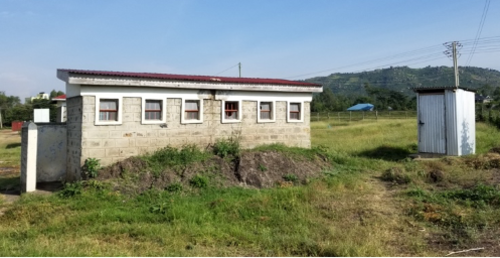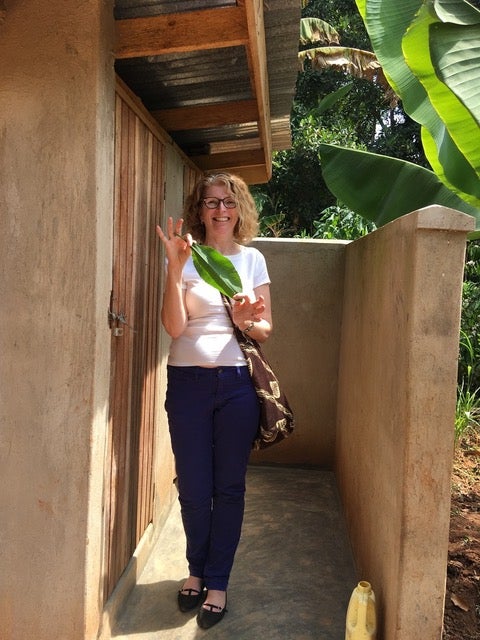Written by Thelma Zulfawu Abu, a Queen Elizabeth Scholar, is a PhD Candidate in Geography and Environmental Management, University of Waterloo (tzabu@uwaterloo.ca)

Collapsed pit latrine on the left and Emergency pit latrine constructed with aluminum roofing sheet on the right in a dispenser in Kisumu, Kenya.
In recent times, almost every day is a global or national something day. Some question the relevance of these days chosen to remember, celebrate or even advocate for an agenda at hand. One of these days is World Toilet Day (WTD), declared by the UN and marked on November 19 every year since 2012. This begs the question why do we have a day for toilets? The answer is simple, this basic human right of access to sanitation services is a challenge and WTD is set aside to remind the world about sanitation challenges faced by many. This also reminds global stakeholders of their commitments to achieve Sustainable Development Goal (SDG) 6: ensuring availability and sustainability management of water and sanitation for all by 2030. Lack of toilets and poor management of waste from toilets cause transmission of diseases like cholera, psychosocial stresses, adolescent female school dropout and undermines women’s safety and privacy (Abu et al., 2019). From the WHO/UNICEF Joint Monitoring Programme for Water Supply, Sanitation and Hygiene (JMP), 673 million people around the world practise open defecation. The lack of access to toilets is more prominent in rural areas and two thirds of people without sanitation services live in developing countries. Basic access to sanitation services means the use of improved facilities (i.e., those designed to hygienically separate excreta from human contact, and include: flush/pour flush to piped sewer system, septic tanks or pit latrines; ventilated improved pit latrines, composting toilets or pit latrines with slabs) which are not shared with other households. This year’s theme for World Toilet Day is sustainable sanitation and climate change. So, what is the relationship between climate change and sanitation?

Professor Susan Elliott outside a vented pit latrine and washroom with a concrete pad - the leaf is ‘toilet paper.'
First, climate change influences the sustainability of sanitation facilities.
A reflection on the disproportionality between rural vs. urban and developing vs. developed in access to sanitation services echoes the 2019 theme for WTD celebrations -leaving no one behind. From this perspective, the 2020 theme is an extension because rural and marginalised communities are more exposed and vulnerable to climate change and do not have the capacity to respond appropriately (Benevolenza & DeRigne, 2019). Many countries in the global south are moving away from subsidising individual household toilets to triggering community members to construct sanitation facilities with their own resources. Many of these countries have embraced the Community Led Total Sanitation (CLTS) approach (Zuin et al., 2019). CLTS is a strategy for eradicating open defecation where community members are mobilised to conduct their own analysis of open defecation and implement their own actions to become open defecation free. This approach is directed towards behaviour change, triggering community members to desire collective action innovations, mutual support and appropriate local solutions, leading to greater ownership and sustainability. Community members desire or aspire to have sanitation facilities and CLTS communities have over average successes yet the resilience of these sanitation facilities to floods, torrential rain and strong winds is a major hinderance to sustainability. The absence of pro poor initiatives and limited financial capacity of rural and marginalised people hinders the construction of resilient sanitation facilities. These people are not only exposed to the yearly collapse of houses and sanitation facilities but also the psychological stress of having to constantly rebuild. Also, damaged sewers cause environmental pollution increasing the risk of exposure to diseases. Sadly, lack of sanitation facilities is not limited to households but includes institutions like healthcare facilities. Infection prevention and control, hygiene and safety in and around healthcare facilities should be of highest standard. Yet globally 21% of health care facilities have no sanitation services, meaning they have unimproved toilets or no toilets at all. This means about 1.5 billion people have no sanitation service at their health care facility (WHO and UNICEF, 2019). Toilets in these institutions also face climate impacts like infrastructural damage (Paterson et al., 2014).
Second, sustainable sanitation facilities can help mitigate climate change.
Both liquid and solid waste from toilets could help reduce climate change by shifting the world towards greener energy production. How is this possible? The construction and use of sustainable toilets where wastewater and sludge are safely stored in tanks, transported appropriately by sewers and treated prior to final disposal could help provided energy for agricultural purposes and gas for cooking. This reduces the emission of greenhouse gases which cause global warming. In some countries, the use of sustainable sanitation facilities for agricultural and domestic purposes is on-going. This initiative is a good one and to appropriately implement without compromising environment and human health requires investments from a variety of stakeholders. According to the JMP 2017 report, no sustainable development region with the exception of Australia and New Zealand are on track to achieving universal basic sanitation access by 2030 (WHO/UNICEF, 2017). The advantages of disease control and mitigating climate change should motivate relevant stakeholders especially political stakeholders to harness political will, commitments and funds to adequately invest in effective and sustainable sanitation services for all by 2030.
In a connected world, lack of access to sanitation services in one community has potential impacts across the globe. Resulting disease outbreaks are not limited or confined to where they originated. Sustainable sanitation services can mitigate greenhouse gases and climate change. It is also our duty as global citizens to continue to advocate for basic human rights and access to life changing services and yes that includes sanitation services.

Thelma Zulfawu Abu, a Queen Elizabeth Scholar, is a PhD Candidate in Geography and Environmental Management, University of Waterloo (tzabu@uwaterloo.ca)
References
Abu, T. Z., Bisung, E., & Elliott, S. J. (2019). What if your husband doesn’t feel the pressure? An exploration of women’s involvement in wash decision making in Nyanchwa, Kenya. International Journal of Environmental Research and Public Health, 16(10). https://doi.org/10.3390/ijerph16101763
Benevolenza, M. A., & DeRigne, L. A. (2019). The impact of climate change and natural disasters on vulnerable populations: A systematic review of literature. Journal of Human Behavior in the Social Environment, 29(2), 266–281. https://doi.org/10.1080/10911359.2018.1527739
Paterson, J., Berr, P., Ebi, K., & Varangu, L. (2014). Health care facilities resilient to climate change impacts. International Journal of Environmental Research and Public Health, 11(12), 13097–13116. https://doi.org/10.3390/ijerph111213097
WHO/UNICEF. (2017). Progress on Drinking Water , Sanitation and Hygiene: 2017 update and SDG Baselines. http://www.who.int/mediacentre/news/releases/2017/launch-version-report-jmp-water-sanitation-hygiene.pdf
WHO and UNICEF. (2019). WaSH in Healthcare Facilities: Global Baseline Report 2019.
Zuin, V., Delaire, C., Peletz, R., Cock-Esteb, A., Khush, R., & Albert, J. (2019). Policy Diffusion in the Rural Sanitation Sector: Lessons from Community-Led Total Sanitation (CLTS). World Development, 124, 104643. https://doi.org/10.1016/j.worlddev.2019.104643